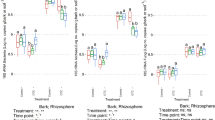Abstract
In ginseng fields, Alternaria blight, caused by Alternaria panax, and anthracnose, caused by Colletotrichum gloeosporoides, have become serious problems in Korea, and control of these diseases relies mainly on intensive applications of fungicides. In an effort to develop an effective environmentally-friendly control system, we utilized preventative control approaches including rain shelter shading plates and the removal of dead plants, as well as a curative control approach, such as the application of microbial agents. In the presence of rain shelter shading plates, the occurrence of Alternaria blight and anthracnose decreased significantly compared to that seen with polyethylene shading nets. In addition, the eradication of dead ginseng plants, which harboured abundant spores of the pathogens, significantly reduced the incidence of both diseases. In fields with rain shelter shading plates and in which dead plants were eradicated, four applications of a bioformulated product containing chitinolytic bacterial strains in a simple medium containing chitin provided control similar in effect to that observed with the application of the fungicide under low disease pressure. The efficacy of the bioformulated product was decreased slightly under severe disease pressure. These findings indicate that integration of the three disease management measures might constitute a new effective and environmentally-friendly system for the control of Alternaria blight and anthracnose in Korean ginseng fields.





Similar content being viewed by others
References
Boland, G. J. (1997). Stability analysis for evaluating the influence of environment on chemical and biological control of white mold (Sclerotinia sclerotiorum) of bean. Biological Control, 9, 7–14.
Favel, D. R. (2005). Commercialization and implementation of biocontrol. Annual review of Phytopathology, 43, 337–359.
Kang, H.-S., Park, D.-S., Hwang, Y.-K., & Kim, S. (2007). Survey on pesticide use by Ginseng growers at Gangwon farmland in Korea. The Korean Journal of Pesticide Science, 11, 210–215.
Kim, Y. H., Yu, Y. H., Cho, D. H., & Ohh, S. H. (1990). Occurrence of Alternaria blight and ginseng yield in different shades. Korean Journal of Plant Pathology, 6, 42–50.
Kim, J., Lee, S. W., Min, J. Y., Bae, Y.-S., Shin, M. U., Kim, S. B., et al. (2007). Development of control system with fungicides against disease of ginseng plant. Research in Plant Disease, 13, 164–169.
Kim, Y. C., Jung, H., Kim, K. Y., & Park, S. K. (2008). An effective biocontrol bioformulation against Phytophthora blight of pepper using growth mixtures of combined chitinolytic bacteria under different field conditions. European Journal of Plant Pathology, 120, 373–382.
Lee, C. Y. (2007). Characterization of photosynthesis with growing stages by different shading materials in Panax giseng C A. Meyer. Korean Journal of Medicinal Crop Sciences, 15, 276–284.
Li, T. S. C., Utkhede, R. S., & Wardle, D. A. (1997). Chemical and biological control of leaf blight and root rot caused by Phytophthora cactorum in American ginseng. Canadian Journal of Plant Pathology, 19, 297–300.
Li, X., Han, J. S., Jin, X., Yin, D., & Choi, J. E. (2008). Control of Alternaria leaf blight of ginseng by microbial agent and fungicides. Research in Plant Disease, 14, 102–106.
McPartland, J., & Hosoya, T. (1998). Species of Colletotrichum on ginseng (Panax). Mycotaxon, 67, 3–8.
Ohh, S. H. (1981). Diseases of Ginseng: environmental and host effect on disease outbreak and growth of pathogens. Korean Journal of Ginseng Science, 5, 73–84.
Ojiambo, O. S., & Scherm, H. (2006). Biological and application-oriented factors influencing plant disease suppression by biological control: a meta-analytical review. Phytopathology, 96, 1168–1174.
Protor, J. T. A. (1996). Ginseng: Old crop, new directions. In J. Janick (Ed.), Progress in new crops (pp. 565–577). Arlington: ASHS.
Punja, Z. K. (1997). Fungal pathogens of American ginseng (Panax quinquefolium) in British Columbia. Canadian Journal of Plant Pathology, 19, 301–306.
Putnam, M. L., & du Toit, L. J. (2003). First report of alternaria blight caused by Alternaria panax on ginseng (Panax quinquefolius) in Oregon and Washington, USA. Plant Pathology, 52, 406.
Quayyum, H. A., Gijzen, M., & Traquair, J. A. (2003). Purification of a necrosis-inducing, host-specific protein toxin from spore germination fluid of Alternaria panax. Phytopathology, 93, 323–328.
Quayyum, H. A., Dobinson, K. F., & Traquair, J. A. (2005). Conidial morphology, virulence, molecular characterization, and host-parasite interactions of selected Alternaria panax isolates on American ginseng. Canadian Journal of Botany, 83, 1133–1143.
Sivakumar, G., Yu, K. W., & Paek, K. Y. (2005). Biosafe ginseng: a novel source for human well-being. Engineering in Life Sciences, 5, 527–533.
Acknowledgments
This research was supported by Basic Science Research Program through the National Research Foundation of Korea (NRF) funded by the Ministry of Education, Science and Technology (grant F00003).
Author information
Authors and Affiliations
Corresponding author
Rights and permissions
About this article
Cite this article
Kim, Y.C., Lee, J.H., Bae, YS. et al. Development of effective environmentally-friendly approaches to control Alternaria blight and anthracnose diseases of Korean ginseng. Eur J Plant Pathol 127, 443–450 (2010). https://doi.org/10.1007/s10658-010-9610-4
Accepted:
Published:
Issue Date:
DOI: https://doi.org/10.1007/s10658-010-9610-4




